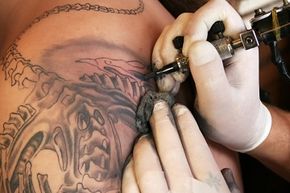You've put a lot of thought, research and money into your tattoo. After all, your new piece of body art is meant to last forever. You want it to be perfect. But after you get your ink, you don't feel so well. Small red bumps, painful skin, swelling and even pus appear at the site of your tattoo. Get to a doctor -- these are symptoms of a staph infection. Staph infections are serious and in some cases, life-threatening.
Contracting a staph infection from a tattoo is rare, but it can happen.
Advertisement
Between 2004 and 2005, 44 people in the U.S. contracted antibiotic-resistant staph infections linked to unlicensed tattoo artists across three different states. The Centers for Disease Control and Prevention reported that the infections resulted from unsanitary conditions including failure to use masks, gloves or sterile needles and ink [source: WebMD].
Staph infection symptoms range from mild (small, itchy skin infections) to serious (deep abscesses requiring medical drainage). In acute cases, staph can burrow deep into the body, causing potentially fatal blood, bone and organ infections. Certain types of staph, such as methicillin-resistant Staphylococcus aureus (MRSA), are very difficult to treat because they don't respond to antibiotics.
You can greatly reduce the risk of contracting a staph infection (or any infectious disease) by following this advice before you sit down in that tattoo chair:
- Never get a tattoo from an unlicensed tattoo artist or someone who works out of his or her home. Always go to a licensed and/or certified shop.
- Your tattoo artist should wear sterile, previously unused gloves.
- Needles should be new (and unwrapped in front of you) and sterile, and the artist should disinfect your skin before starting the tattoo.
- Ink containers should be used for one client only and for one sitting only.
- The fresh tattoo must be disinfected and covered with a sterile bandage after the procedure.
- Strictly follow your artist's aftercare instructions and contact a doctor if you notice any sign of infection.
Staph infections aren't your only risk -- hepatitis B and C, HIV and tetanus are also possibilities if unclean needles are involved. Leave the inking to the pros. Very clean pros.
Advertisement


